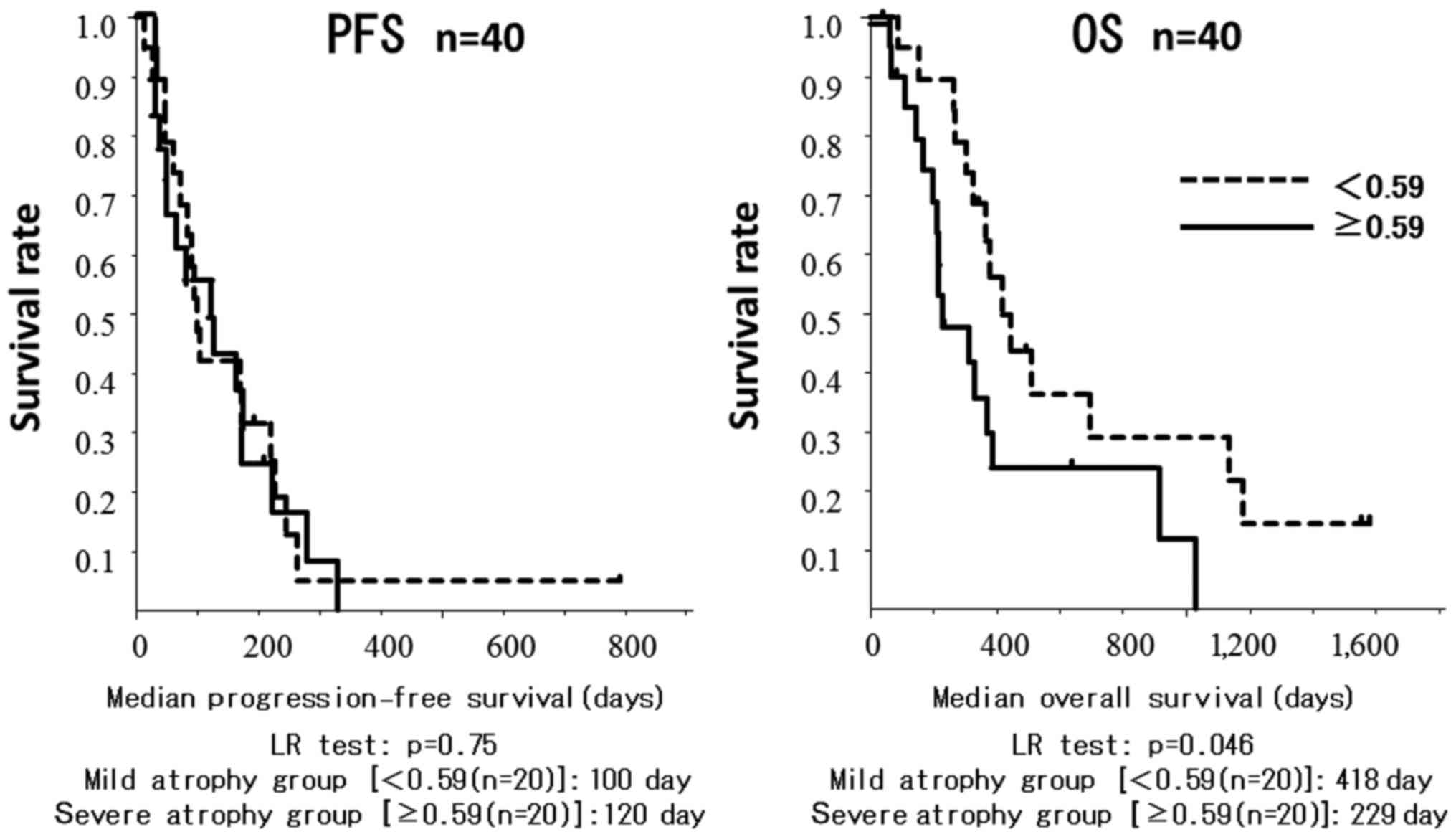|
1
|
Tandon P, Ney M, Irwin I, Ma MM, Gramlich
L, Bain VG, Esfandiari N, Baracos V, Montano-Loza AJ and Myers RP:
Severe muscle depletion in patients on the liver transplant wait
list: Its prevalence and independent prognostic value. Liver
Transpl. 18:1209–1216. 2012. View
Article : Google Scholar : PubMed/NCBI
|
|
2
|
Montano-Loza AJ, Meza-Junco J, Prado CM,
Lieffers JR, Baracos VE, Bain VG and Sawyer MB: Muscle wasting is
associated with mortality in patients with cirrhosis. Clin
Gastroenterol Hepatol. 10:166–173.e1. 2012. View Article : Google Scholar : PubMed/NCBI
|
|
3
|
Hanai T, Shiraki M, Nishimura K, Ohnishi
S, Imai K, Suetsugu A, Takai K, Shimizu M and Moriwaki H:
Sarcopenia impairs prognosis of patients with liver cirrhosis.
Nutrition. 31:193–199. 2015. View Article : Google Scholar : PubMed/NCBI
|
|
4
|
Nishikawa H, Shiraki M, Hiramatsu A,
Moriya K, Hino K and Nishiguchi S: Japan Society of Hepatology
guidelines for sarcopenia in liver disease (1st edition):
Recommendation from the working group for creation of sarcopenia
assessment criteria. Hepatol Res. 46:951–963. 2016. View Article : Google Scholar : PubMed/NCBI
|
|
5
|
Imai K, Takai K, Hanai T, Ideta T,
Miyazaki T, Kochi T, Suetsugu A, Shiraki M and Shimizu M: Skeletal
muscle depletion predicts the prognosis of patients with
hepatocellular carcinoma treated with sorafenib. Int J Mol Sci.
16:9612–9624. 2015. View Article : Google Scholar : PubMed/NCBI
|
|
6
|
Hiraoka A, Hirooka M, Koizumi Y, Izumoto
H, Ueki H, Kaneto M, Kitahata S, Aibiki T, Tomida H, Miyamoto Y, et
al: Muscle volume loss as a prognostic marker in hepatocellular
carcinoma patients treated with sorafenib. Hepatol Res. 47:558–565.
2017. View Article : Google Scholar : PubMed/NCBI
|
|
7
|
Durand F, Buyse S, Francoz C, Laouénan C,
Bruno O, Belghiti J, Moreau R, Vilgrain V and Valla D: Prognostic
value of muscle atrophy in cirrhosis using psoas muscle thickness
on computed tomography. J Hepatol. 60:1151–1157. 2014. View Article : Google Scholar : PubMed/NCBI
|
|
8
|
Liver Cancer Study Group of Japan,
corp-author. General Rules for the Clinical and Pathological Study
of Primary Liver Cancer. 5th. Kanehara & Co., Ltd.; Tokyo: pp.
242009
|
|
9
|
Llovet JM, Ricci S, Mazzaferro V, Hilgard
P, Gane E, Blanc JF, de Oliveira AC, Santoro A, Raoul JL, Forner A,
et al: Sorafenib in advanced hepatocellular carcinoma. N Engl J
Med. 359:378–390. 2008. View Article : Google Scholar : PubMed/NCBI
|
|
10
|
Cheng AL, Kang YK, Chen Z, Tsao CJ, Qin S,
Kim JS, Luo R, Feng J, Ye S, Yang TS, et al: Efficacy and safety of
sorafenib in patients in the Asia-Pacific region with advanced
hepatocellular carcinoma: A phase III randomised, double-blind,
placebo-controlled trial. Lancet Oncol. 10:25–34. 2009. View Article : Google Scholar : PubMed/NCBI
|
|
11
|
Bruix J, Raoul JL, Sherman M, Mazzaferro
V, Bolondi L, Craxi A, Galle PR, Santoro A, Beaugrand M,
Sangiovanni A, et al: Efficacy and safety of sorafenib in patients
with advanced hepatocellular carcinoma: Subanalyses of a phase III
trial. J Hepatol. 57:821–829. 2012. View Article : Google Scholar : PubMed/NCBI
|
|
12
|
Hollebecque A, Cattan S, Romano O, Sergent
G, Mourad A, Louvet A, Dharancy S, Boleslawski E, Truant S, Pruvot
FR, et al: Safety and efficacy of sorafenib in hepatocellular
carcinoma: The impact of the Child-Pugh score. Aliment Pharmacol
Ther. 34:1193–1201. 2011. View Article : Google Scholar : PubMed/NCBI
|
|
13
|
Montano-Loza AJ: Clinical relevance of
sarcopenia in patients with cirrhosis. World J Gastroenterol.
20:8061–8071. 2014. View Article : Google Scholar : PubMed/NCBI
|
|
14
|
Periyalwar P and Dasarathy S: Malnutrition
in cirrhosis: Contribution and consequences of sarcopenia on
metabolic and clinical responses. Clin Liver Dis. 16:95–131. 2012.
View Article : Google Scholar : PubMed/NCBI
|
|
15
|
Toshikuni N, Arisawa T and Tsutsumi M:
Nutrition and exercise in the management of liver cirrhosis. World
J Gastroenterol. 20:7286–7297. 2014. View Article : Google Scholar : PubMed/NCBI
|
|
16
|
Kaibori M, Ishizaki M, Matsui K, Nakatake
R, Yoshiuchi S, Kimura Y and Kwon AH: Perioperative exercise for
chronic liver injury patients with hepatocellular carcinoma
undergoing hepatectomy. Am J Surg. 206:202–209. 2013. View Article : Google Scholar : PubMed/NCBI
|
|
17
|
Sanada K, Miyachi M, Tanimoto M, Yamamoto
K, Murakami H, Okumura S, Gando Y, Suzuki K, Tabata I and Higuchi
M: A cross-sectional study of sarcopenia in Japanese men and women:
Reference values and association with cardiovascular risk factors.
Eur J Appl Physiol. 110:57–65. 2010. View Article : Google Scholar : PubMed/NCBI
|
|
18
|
Tanimoto Y, Watanabe M, Sun W, Hirota C,
Sugiura Y, Kono R, Saito M and Kono K: Association between muscle
mass and disability in performing instrumental activities of daily
living (IADL) in community-dwelling elderly in Japan. Arch Gerontol
Geriatr. 54:e230–e233. 2012. View Article : Google Scholar : PubMed/NCBI
|
|
19
|
Hiraoka A, Aibiki T, Okudaira T, Toshimori
A, Kawamura T, Nakahara H, Suga Y, Azemoto N, Miyata H, Miyamoto Y,
et al: Muscle atrophy as pre-sarcopenia in Japanese patients with
chronic liver disease: Computed tomography is useful for
evaluation. J Gastroenterol. 50:1206–1213. 2015. View Article : Google Scholar : PubMed/NCBI
|
|
20
|
Yoshizumi T, Shirabe K, Nakagawara H,
Ikegami T, Harimoto N, Toshima T, Yamashita Y, Ikeda T, Soejima Y
and Maehara Y: Skeletal muscle area correlates with body surface
area in healthy adults. Hepatol Res. 44:313–318. 2014. View Article : Google Scholar : PubMed/NCBI
|










